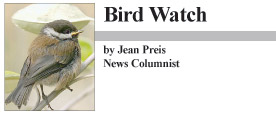Big Birds
 A few years ago, a woman in Denmark (our local Denmark, not the country) phoned to tell me she had seen a bird about the size of a great blue heron, except it was all white. She had seen a great egret, a close relative of the great blue heron, who sometimes wanders north after the breeding season to visit our coastal marshes. Once in a while, a few come inland to visit our secluded wetlands.
A few years ago, a woman in Denmark (our local Denmark, not the country) phoned to tell me she had seen a bird about the size of a great blue heron, except it was all white. She had seen a great egret, a close relative of the great blue heron, who sometimes wanders north after the breeding season to visit our coastal marshes. Once in a while, a few come inland to visit our secluded wetlands.
Last week, I heard about another large bird who is visiting our area, and this one was even more unexpected than the egret, so a friend and I went to look for it. We drove west to Fryeburg Harbor, where the Old Course of the Saco River winds through a beautiful broad valley. Dark clouds hung low over the western mountains, threatening rain, as we cruised the quiet roads and scanned the fields for the bird. At this time of year, the fields are filled with corn, or potatoes, or are bright green carpets of new sod, separated by areas of tall vegetation. There are many places a bird, even a very large bird, could hide, so we were relieved to encounter another birder who signaled for us to follow his little red car. He led us to an overgrown field where he had seen the bird a few days earlier, but the bird was nowhere to be seen. My friend and I continued to drive and look, until a black pick-up truck pulled up alongside our car and I recognized another birding acquaintance, a local farmer. He had seen the bird an hour earlier, and with his help we finally found it walking along the edge of a sod field.
The bird was very tall and stately, with long legs, and a long graceful neck held straight up. It was as large as a great blue heron, or a great egret, but it was not a heron or an egret, it was a sandhill crane. Although sandhill cranes may superficially resemble great blue herons and great egrets, they belong to a different family and live a very different lifestyle. Sandhill cranes have a distinctive patch of red skin on the top of the head, and the feathers on the bird’s rump form what looks like the bustle that was popular on women’s dresses in the late 1800s. I had seen these cranes in other parts of the country in winter, when they are a lovely gray color, so I was surprised to see that this bird was entirely reddish brown, except for gray on the upper part of the neck. Later, at home, I checked several reference books. From The Audubon Society Master Guide to Birding, Vol. 1, I learned that their plumage becomes stained in spring when the adult birds preen their feathers with mud containing iron, which then oxidizes and blends with the feather pigments. At the end of summer when the feathers molt, the new feathers are gray. We watched as the tall crane walked slowly, reaching its long neck down to the ground to search for food. According to the Birder’s Handbook, they are opportunistic feeders, eating everything from aquatic invertebrates, insects, worms, small mammals, young birds and eggs, to seeds, grass shoots, grains, berries, lichen, and aquatic plants. There would be plenty of food in this valley for a crane.
Sandhill cranes have summered in Maine for many years. James Rosier, who explored the Georges Islands of Knox County from May 19 to June 16, 1605, recorded their presence, but did not present convincing evidence that they nested there. By the time Ralph S. Palmer included Rosier’s report in his 1949 book, Maine Birds, it was believed the cranes had been extirpated from Maine. In more recent years, sandhill cranes have been seen in Maine, but are considered rare. This summer an adult and a juvenile have been observed in the Belgrade area, evidence of successful nesting.
The sandhill crane in Fryeburg Harbor has been seen in fields along Harbor Road and McNeil Road, so it’s worth taking a careful look there. Any large bird flying overhead is worth a second look, too. If the bird is dark, or all white, and flies with its long neck looped back, it might be a great blue heron or a great egret, but if it flies with the long neck extended straight out, it just might be a sandhill crane.
Jean Preis is a resident of Bridgton, and has led bird-watching hikes throughout the Lake Region area.

